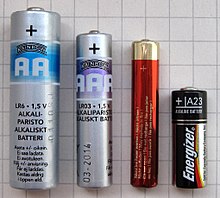Electric potential difference
| Voltage | |
|---|---|

Batteries are sources of voltage in many electric circuits
|
|
|
Common symbols
|
V , ∆V U , ∆U |
| SI unit | volt |
Voltage, electric potential difference, electric pressure or electric tension (formally denoted ∆V or ∆U, but more often simply as V or U, for instance in the context of Ohm's or Kirchhoff's laws) is the difference in electric potential energy between two points per unit electric charge. The voltage between two points is equal to the work done per unit of charge against a static electric field to move the test charge between two points and is measured in units of volts (a joule per coulomb).
Voltage can be caused by static electric fields, by electric current through a magnetic field, by time-varying magnetic fields, or some combination of these three. A voltmeter can be used to measure the voltage (or potential difference) between two points in a system; often a common reference potential such as the ground of the system is used as one of the points. A voltage may represent either a source of energy (electromotive force) or lost, used, or stored energy (potential drop).
Given two points in space, and , voltage is the difference in electric potential between those two points. From the definition of electric potential it follows that:
...
Wikipedia


